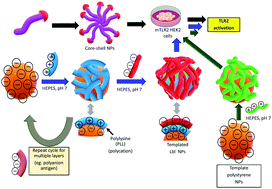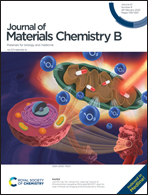Engineering immunomodulatory nanoplatforms from commensal bacteria-derived polysaccharide A†
Abstract
Capsular zwitterionic polysaccharides (CZPs), typically found on the surfaces of commensal gut bacteria, are important immunomodulatory molecules due to their ability to produce a T cell dependent immune response upon processing by antigen presenting cells (APCs). Their immunological activity makes them potentially useful for generating material constructs that are applicable for the treatment of diseases, or as vaccines. Herein, we explored synthetic strategies to generate immunologically active polymer–carbohydrate conjugates and nanomaterials of the CZP, Polysaccharide A (PSA) derived from Bacteroides fragilis. Initially, we addressed the purification of PSA, which is critical for the realization of materials applicable for biomedical purposes. Anion exchange high performance liquid chromatography in the presence of a surfactant (CHAPS) enabled the isolation of pure PSA. Through modification of purified PSA with azide groups, we demonstrated that polymers or antigens could be incorporated with PSA via click chemistry reactions to generate conjugates that can be fabricated into nanoparticles. By conjugation of PSA with a DBCO end functionalized polyphosphoester polymer with hydrophobic pendant terminal alkyne groups, an amphiphilic conjugate was obtained which formed nanoparticles of about 100 nm in aqueous solution. Moreover, terminal alkyne groups could be modified with charged thiol molecules (amine/carboxylate) via thiol–yne radical chemistry to generate conjugates, which could be incorporated into nanoparticles via electrostatic interactions building onto a charged nanoparticle template. The conjugates and nanoparticles exhibited immunological activity as assessed by the toll-like receptor 2 (TLR2) activation assay and positive cytokine production (IL-10) following their co-incubation with APCs and T cells. Summarily, this work plainly demonstrates chemical biology strategies for fabricating immunomodulatory nanomaterials from commensal microorganisms that can potentially be novel vaccines or immunotherapeutics.



 Please wait while we load your content...
Please wait while we load your content...